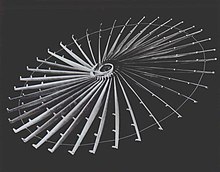Kinetic energy weapon
This article needs additional citations for verification. (December 2023) |

A kinetic energy weapon (also known as kinetic weapon, kinetic energy warhead, kinetic warhead, kinetic projectile, kinetic kill vehicle) is a
Kinetic weapons are the oldest and most common ranged weapons used in
The term hit-to-kill, or kinetic kill, is also used in the military aerospace field to describe kinetic energy weapons accelerated by a rocket engine. It has been used primarily in the anti-ballistic missile (ABM) and anti-satellite weapon (ASAT) fields, but some modern anti-aircraft missiles are also kinetic kill vehicles. Hit-to-kill systems are part of the wider class of kinetic projectiles, a class that has widespread use in the anti-tank field.
Basic concept
At that speed, every kilogram of the interceptor will have an energy of:
TNT has an explosive energy of about 4853 joules per gram,[3] or about 5 MJ per kilogram. That means the impact energy of the mass of the interceptor is over five times that of a detonating warhead of the same mass.[2]
It may seem like this makes a warhead superfluous, but a hit-to-kill system has to actually hit the target, which may be on the order of half a meter wide, while a conventional warhead releases numerous small fragments that increase the possibility of impact over a much larger area, albeit with a much smaller impact mass. This has led to alternative concepts that attempt to spread out the potential impact zone without explosives.
As the accuracy and speed of modern
Delivery
This section needs additional citations for verification. (December 2023) |
Some kinetic weapons for targeting objects in
With regard to anti-missile weapons, the
A kinetic projectile can also be dropped from aircraft. This is applied by replacing the explosives of a regular bomb with a non-explosive material (e.g. concrete), for a precision hit with less
Advantages and disadvantages
The primary advantage kinetic energy weapons is that they minimize the launch mass of the weapon, as no weight has to be set aside for a separate warhead. Every part of the weapon, including the airframe, electronics and even the unburned maneuvering fuel contributes to the destruction of the target. Lowering the total mass of the vehicle offers advantages in terms of the required launch vehicle needed to reach the required performance, and also reduces the mass that needs to be accelerated during maneuvering.[2]
Another advantage of kinetic energy weapons is that any impact will almost certainly guarantee the destruction of the target. In contrast, a weapon using a
No chemical munitions in the weapons also means that there is far less pollution of an area from a kinetic weapon.
The main disadvantage of the kinetic energy weapons is that they require extremely high accuracy in the guidance system, on the order of 0.5 metres (2 ft).[2]
See also
- Exoatmospheric Kill Vehicle – Interceptor part of the Ground-Based Midcourse Defense manufactured by Raytheon
- Hellfire R9X– American air-to-surface missile
- Kinetic bombardment – Orbit to planetary surface attack with inert projectiles
- Terminal ballistics – Projectiles' behavior after reaching their targets
Explanatory notes
- ^ As opposed to the anti-tank field, where the velocity of the tank can be approximated as zero compared to that of the weapon.
References
- ISBN 978-81-203-3862-3.
- ^ a b c d e f GlobalSecurity.
- ISBN 978-0-471-18636-6.
- ISBN 9781603446914.
- ^ "Striking a Bullet with a Bullet: HOE". Lockheed Martin. 2020-10-01. Archived from the original on 2023-09-20. Retrieved 2023-10-21.
- ^ HeadOn.
- ^ "RIM-161 SM-3 (AEGIS Ballistic Missile Defense)". GlobalSecurity.org.
Bibliography
- "Missile Defense: Meeting the Challenge Head On". Lockheed Martin. 22 March 2018.
- "Kinetic Energy Hit-To-Kill Warhead". GlobalSecurity.org.
External links
 Media related to Kinetic energy weapon at Wikimedia Commons
Media related to Kinetic energy weapon at Wikimedia Commons

